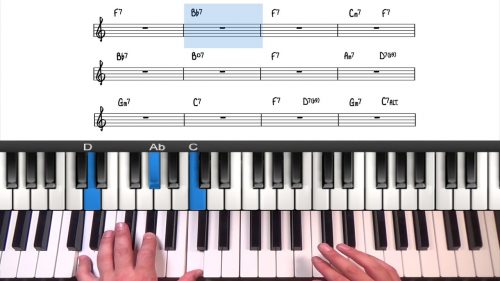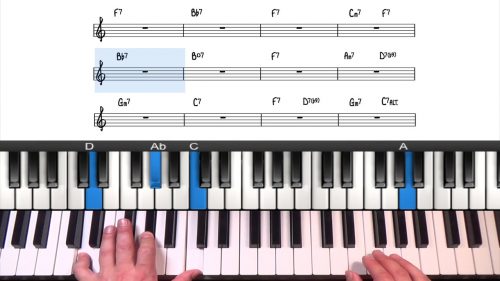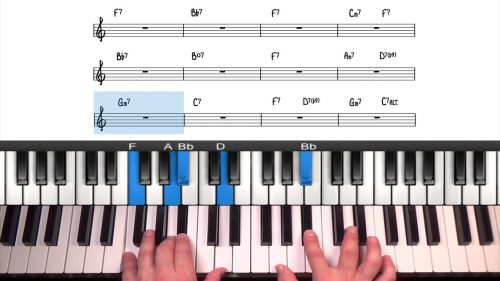The 12 Bar Form & Variations
In this lesson we’re going to explore the harmonic and rhythmic structure of the blues. The information in this lesson is essential to understand how the blues is constructed and how it is most commonly played.
The Harmonic Structure
The 12 bar form is the most basic and common type of blues form. However, there are other variations such as 8 bars blues, 16 bar blues, and 32 bar blues.
The most basic variation of the 12 bar blues is comprised of just 3 chords:
- The I7 Chord
- The IV7 Chord
- The V7 Chord
We will start by constructing the blues with just these 3 chords and then we will explore the variations and substitutions that we can apply to this basic structure.
The ‘Quick IV’ Variation
The first variation we will explore is the ‘Quick IV’ variation in bar 2 of the progression.
In the basic 12 bar form, the I7 chord lasts for the first 4 bars. By adding the ‘Quick IV’ we create more harmonic variety for the first line and this is a very common addition to the basic 12 bar structure.
Bars 9, 10, & 11 – V7 to IV7 back to I7
In the most basic version of the blues, we stay on the V7 chord for bars 9 & 10 before returning to the I7 chord in bar 11.
Another variation that is commonly used – perhaps even more common than the quick IV – is an additional IV7 chord in bar 10 of the form.
Connect Each Chorus With Turnarounds
When playing the 12 bar blues, it’s common to play many choruses during a single performance. We use turnarounds at the end of the form to propel each chorus into the next.
The turnaround ends on the V7 chord which creates a strong pull back to the I7 chord to start the form over again.
Without the turnaround, the final two bars would be on the I7 chord. As the progression starts on the I7 chord, this creates a long section of static harmony.
We explore turnaround variations in more detail in lesson 6 of this course.
Rhythmic Feel: Straight 8th Notes
The rhythmic structure of the blues has many forms and permutations. However, the most common types of rhythmic feel are the straight 8th note feel and the shuffled 8th note feel.
A straight 8th note feel is simply two 8th notes per one quarter note. This can be counted as:
1 & 2 & 3 & 4 & 1 & 2 & 3 & 4 & etc…
The Boogie Woogie rhythm uses a straight 8th note feel. For more information check out Steve’s course on Boogie Woogie Piano.
Rhythmic Feel: Shuffle 8th Notes/8th Note Triplets
The shuffle feel – also known as the 8th note triplet feel – is perhaps the most common rhythmic feel for the blues.
Here, we divide each quarter note into 8th note triplets as Steve demonstrates with the clapping exercises.
By excluding the middle triplet, we create an interesting rhythmic feel called a ‘shuffle’ that can be likened to bouncing a ball. This is the most important rhythmic feel to internalise as we discuss in lesson 3 of this course.
Lesson Downloads
-
12 Bar Blues Variations File Type: pdf
Practice Tips
-
Play around and around the 12 bar form to get the harmonic structure implanted in your mind, body, & soul.
-
Steve demonstrates useful clapping exercises to help develop our hand independence and awareness of 8th notes, quarter notes, and whole notes.
-
Practice these clapping exercises whilst away from the piano to work on your sense of feel and awareness of bars and form.








Nice bouncy left-hand playing. it is interesting to observe the change in sound between straight and shuffle feel. A lot of applicability in real situations in both styles.
Thanks, @Hayden for your advice on DrumGenius, it really improved my daily practice routine.
Thanks Eugene – glad to hear you enjoyed the lessons and the DrumGenius App.
Cheers,
Hayden